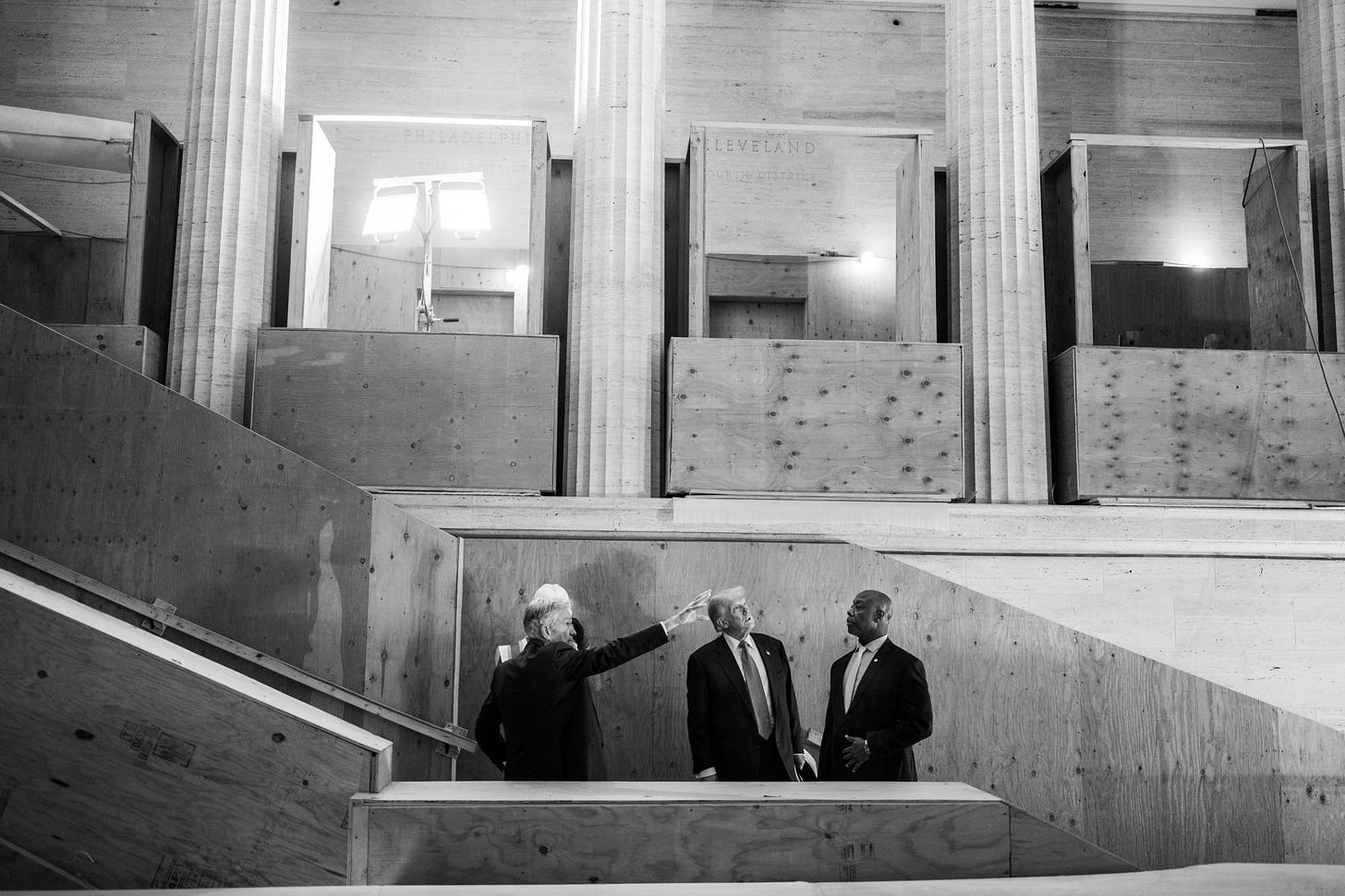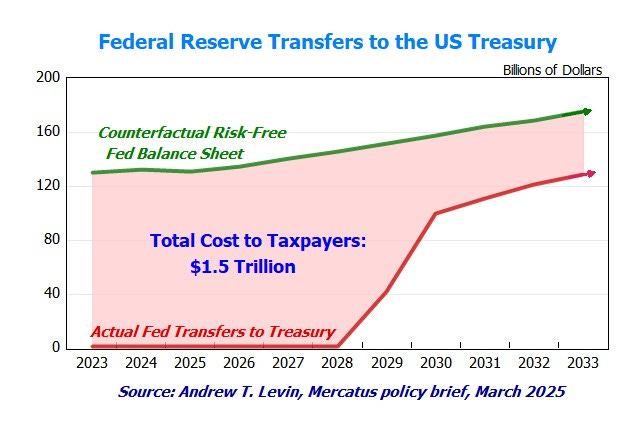A Boring Central Bank
Stronger Fed Oversight in an Era of Big Headlines, Bigger Operating Losses

In recent years, the Federal Reserve’s actions—from quantitative easing to emergency lending and aggressive rate hikes—have kept it in the headlines.
As Kevin Warsh, a contender for the next Fed chair, recently put it, the Fed once aspired to be “a rather boring central bank,” buried on “page B12 of the newspaper” with “six little paragraphs” about modest rate changes. That, he said, was the implicit promise of the 2008 crisis—that extraordinary powers would be temporary. But, as Warsh noted, “from that moment until this moment, the central bank became front page news.”
Last month, however, the Fed found itself in the headlines for something other than monetary policy: a $3.1 billion overhaul of its Washington headquarters, punctuated by a presidential tour that included a tense (and highly memeable) exchange between President Trump and Fed Chair Powell. Operational details rarely draw national headlines, but the steep price tag and public filings describing high-end amenities, including major structural changes, caught the attention of the media, Congress, and the White House. Looking past the headlines, the HQ upgrade raises broader questions about the Fed’s stewardship of public funds and provides a concrete—or, in this case, marble—illustration of the relationship between the Fed’s spending and the federal budget.
The Hidden Budget Impact of Federal Reserve Spending
The HQ upgrade is just one visible example of a larger point: The Fed’s spending influences how much money flows to the Treasury. While many understand that the Fed has a unique self-financing structure, it’s often wrongly assumed this means its spending has no impact on taxpayers. By law, the Federal Reserve must remit its operating profits to the U.S. Treasury for the benefit of taxpayers. In profitable times, every dollar spent on headquarters renovations is a dollar less remitted to the Treasury—money that could otherwise help fund the government or reduce the national debt.
These expenditures don’t affect the debt ceiling, but they still matter for accountability. In defending the project’s overruns, Chair Powell has emphasized the Fed’s duty to be a good steward of public resources.
The Deferred Asset and Mounting Losses
Since its founding more than a century ago, the Federal Reserve has almost always operated at a profit, earning income from interest on its securities holdings and fees for services it provides to the financial system. That changed in mid-2022, when the Fed began recording sustained operating losses—largely because of a fourth round of quantitative easing, or QE4, which doubled the size of its balance sheet from around $4 trillion to nearly $9 trillion between 2020 and 2022. As the Fed raised interest rates to fight inflation, it also raised its own expenses, effectively hiking itself into a loss, as the interest it now pays on bank reserves and reverse repos quickly outpaced the low, fixed returns on its long-term securities.
The result has been billions in monthly losses and the buildup of an unusual item on the Fed’s balance sheet: the deferred asset. The Federal Reserve, unlike private businesses, can’t go bankrupt, but that doesn’t mean losses are written off. Instead of recognizing a traditional loss, the Fed records the cumulative shortfall as a negative liability, known as a deferred asset, on its balance sheet. Like a household that runs up a credit card and must pay it off before saving again, the Fed must clear this balance before resuming remittances to the Treasury. Simply put, these losses delay Treasury transfers, indirectly burdening future budgets until the Fed’s earnings recover.
More Than a Rounding Error
This brings us back to the question of the HQ overhaul. Whether the Fed is running a profit or a loss, how it spends money—including on its headquarters—still affects the federal budget indirectly. While some argue that this spending warrants scrutiny, a common counterargument is that the renovation costs are trivial in context: a few billion on a project is no more than a rounding error on the Fed’s balance sheet.
But that misses the point. The Fed is a steward of public resources and should be held to the same standards of transparency and accountability as any other federal agency. Rounding errors can do immeasurable damage to public trust that’s easy to lose but hard to regain.
Unlike other federal agencies such as the Securities and Exchange Commission, which is also self-funded but still subject to routine oversight, the Fed operates with relatively few external accountability checks. For example, the Fed has an inspector general, but the Fed’s IG is not truly independent because it reports directly to the Fed Chair instead of Congress. On July 14, Chair Powell informed Congress that he would instruct the Board’s IG to “take a fresh look at the project.” That announcement came just four days after OMB Director Russell Vought sent a letter to the Fed demanding answers about the project’s cost overruns, alleged mismanagement, and compliance with the National Capital Planning Act.
A Symbol of Deeper Problems
The headquarters project stands as a telling symbol of the Fed’s broader financial problems and lack of transparency—one the public can easily grasp. When you tell someone the Fed is spending as much on renovating its headquarters as it would take to build a sports stadium, people get it. What’s harder to visualize are the costs of the Fed’s pandemic-era bond-buying program, QE4. As discussed earlier, since mid-2022 the Fed has been running sustained operating losses, and as of August 2025, $238 billion has accumulated in the deferred asset. Economist Andrew Levin, in research published by the Mercatus Center, estimates that QE4 post-2022 operating losses could ultimately result in $1.5 trillion in foregone remittances to the U.S. Treasury. Figure 1 illustrates this point:
FIGURE 1.

Levin notes: “The Fed did not alert Congress about the potential costs of QE4 while this program was being conducted, nor has it provided any cost-benefit analysis in the three years since the program ended.”
The Fed is accountable to Congress, yet the Fed’s opaque, hierarchical structure and lack of transparency have kept lawmakers in the dark on what could amount to over $1.5 trillion in costs to taxpayers—more than a rounding error by any measure. These concerns are especially urgent against the backdrop of increasingly unsustainable budget deficits, which risk putting upward pressure on rates if not addressed. A return to the low interest rates of the 2010s is far from guaranteed.
Restoring Accountability
How can the Fed recede from front-page controversy and find itself tucked away on page B12 once again? More oversight could help.
Treasury Secretary Scott Bessent recently called on the Fed to conduct a thorough internal review of its non-monetary policy operations. He cited headquarters cost overruns, mission creep in areas like climate initiatives, and the management of its balance sheet amid operating losses. This would be a start, but in many ways would be more of the same internal oversight that already exists. A more meaningful reform would be the creation of a truly independent inspector general—one nominated by the president and confirmed by the Senate, as is standard for every other major federal agency.
Other reforms are also worth serious consideration. Other central banks offer useful examples: the European Central Bank is regularly audited by the European equivalent of the GAO, and the Bank of England recently welcomed an external review led by former Fed chair and Nobel laureate Ben Bernanke. If the Fed truly wants to restore public trust, it should embrace similar mechanisms: independent evaluations, clear reporting requirements, and stronger channels for congressional oversight.
Congress could also establish a blue-ribbon commission to examine the Fed’s governance structure. The current FOMC structure gives the Fed chair outsized control over both policy decisions and public messaging, and dissents on the 12-person committee are rare. This was recently illustrated in July, when the dual dissent by Governors Waller and Bowman—the first time multiple governors dissented since 1993—made headlines. Reforming the FOMC to promote measured dissent, inspired by the Supreme Court’s transparent debates, could enhance accountability and public trust. Such changes could also reduce the outsized political pressure that tends to concentrate on the chair.
A More Trustworthy, Less Flashy Fed
These reforms wouldn’t compromise the Fed’s independence in setting monetary policy. Instead, they would strengthen the institution’s capacity to make sound decisions and rebuild public trust.
And in doing so, the Fed could perhaps once again become the kind of “boring central bank” that belongs on page B12 rather than the front page.

